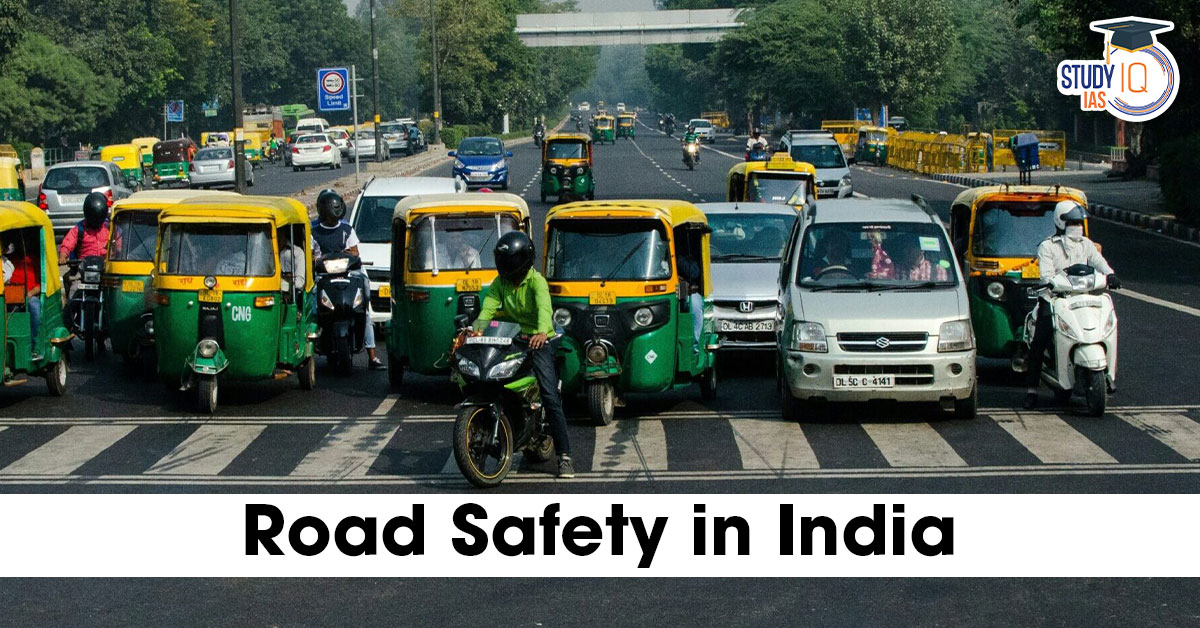Table of Contents
Context: India faces a road safety crisis, which calls for an urgent need to ensure road safety.
Why Is There an Urgent Need to Ensure Road Safety in India?
- High Fatalities: India recorded 68 lakh road accident deaths in 2022, with a fatality rate of 12.2 per lakh population, far higher than countries like Japan (2.57) and UK (2.61).
- Massive Economic Loss: Road crashes cost 3% of India’s GDP annually, hindering national productivity and growth.
- Human Rights Concern: Safe travel is part of Article 21 – Right to Life. Every citizen has a right to safe public spaces, including roads.
- Urbanisation & Mobility Surge: By 2047, nearly 50% of Indians will live in urban areas, increasing vehicle ownership and vulnerability of road users.
- Impact on Vulnerable Groups: Pedestrians, cyclists, children, the elderly, and public transport users are most at risk due to poor infrastructure and road behaviour.
- Global Commitments: India is a signatory to the UN’s Decade of Action for Road Safety and has committed to reducing fatalities by 50% by 2030.
Key Challenges in Road Safety in India
- Poor Road Design & Black Spots: Lack of pedestrian infrastructure, unscientific intersections, and accident-prone zones.
- Enforcement Gaps: Weak enforcement of speed limits, drunk driving rules, helmet and seatbelt use.
- Lack of Road User Education: Public unawareness about road signs, traffic discipline, and safe practices.
- Inadequate Driver Training: Many drivers, especially in rural areas, operate vehicles without formal training or licenses.
- Emergency Response Deficiencies: Poor post-crash care due to delayed ambulance response and inadequate trauma centres.
- Fragmented Institutional Framework: Road safety responsibilities are divided across multiple agencies without effective coordination.
Government’s Recent Interventions for Road Safety in India
- Engineering (Infrastructure): Identification and rectification of 5,000+ black spots on highways.
- Mandatory road safety audits for highway projects.
- Enforcement: Implementation of electronic surveillance: speed cameras, CCTVs.
- Strict rules on seatbelts, helmets, and anti-lock braking systems (ABS).
- Education: Awareness campaigns and inclusion of road safety in the school curriculum.
- Focus on people-centric urban design (Safe System Approach).
- Emergency Care: Push for more trauma care centres and faster ambulance networks.
- Good Samaritan law protects bystanders helping accident victims.
- Training Initiatives: Setting up driver training & vehicle fitness centres in every district (MoRTH initiative).
Recommendations and Way Forward
- Adopt Safe System Approach: Design roads forgiving of human errors — wide footpaths, cycle tracks, raised crossings, and slower urban speed limits.
- CSR-Based Funding Model: Mandate automakers to use their CSR funds for road safety for 20–25 years — covering education, emergency care, and black spot removal.
- Data-Driven Policy & Accountability: Real-time crash data collection and transparent public dashboards to monitor road safety performance.
- Urban Planning for Vulnerable Users: Prioritise pedestrian-first infrastructure in Smart Cities and urban expansion projects.
- Integrated 4E Strategy: Strengthen coordination across Engineering, Enforcement, Education, and Emergency Care.
- Investment Push: Implement World Bank’s $109 billion roadmap to cut fatalities by 50%, with returns up to ₹4 saved per ₹1 invested.
Conclusion
Road safety in India is not merely a technical issue but a societal imperative and constitutional right. With rising urbanisation and vehicle penetration, India stands at a crossroads — either continue with fragmented efforts or implement a bold, inclusive, and data-backed road safety regime. A Vision Zero approach, rooted in human dignity, must guide India’s mobility future.


 Geo-tagging of Buildings During Upcoming...
Geo-tagging of Buildings During Upcoming...
 Gender Gap in Educational Expenditure in...
Gender Gap in Educational Expenditure in...
 Reservation and 50% Cap: Constitutional ...
Reservation and 50% Cap: Constitutional ...

























